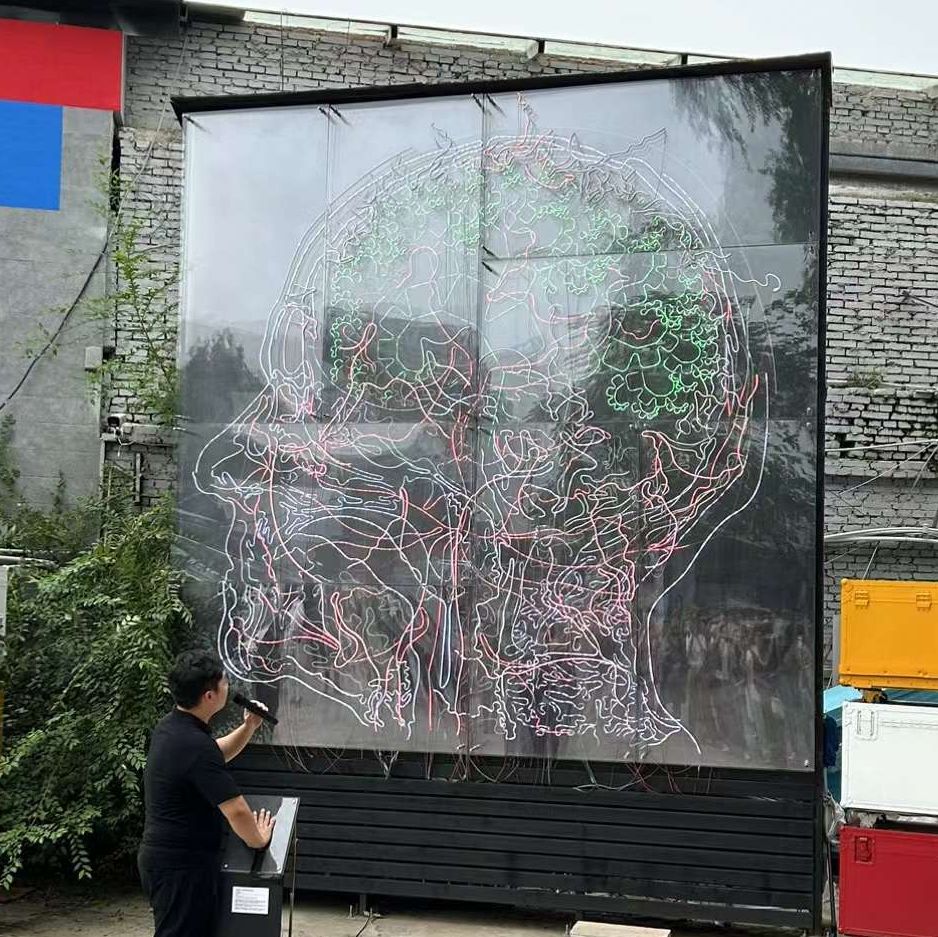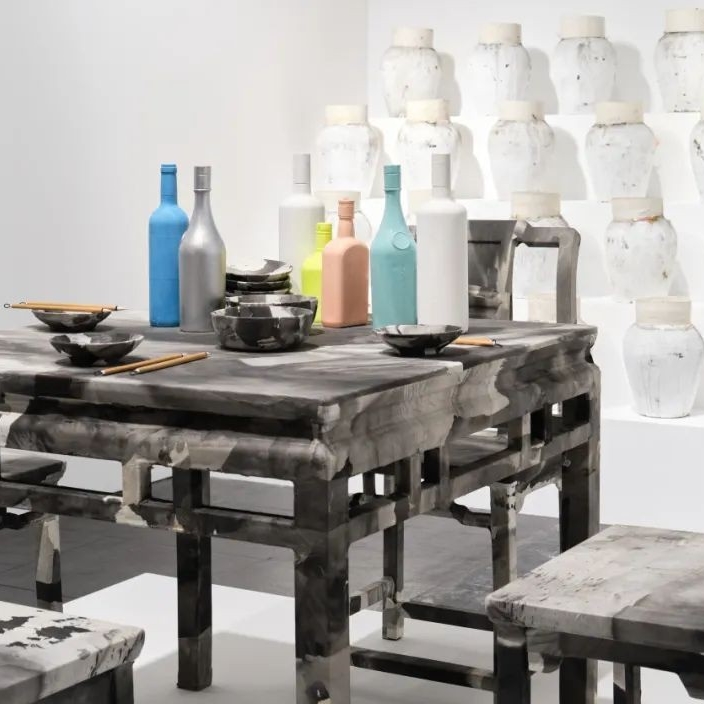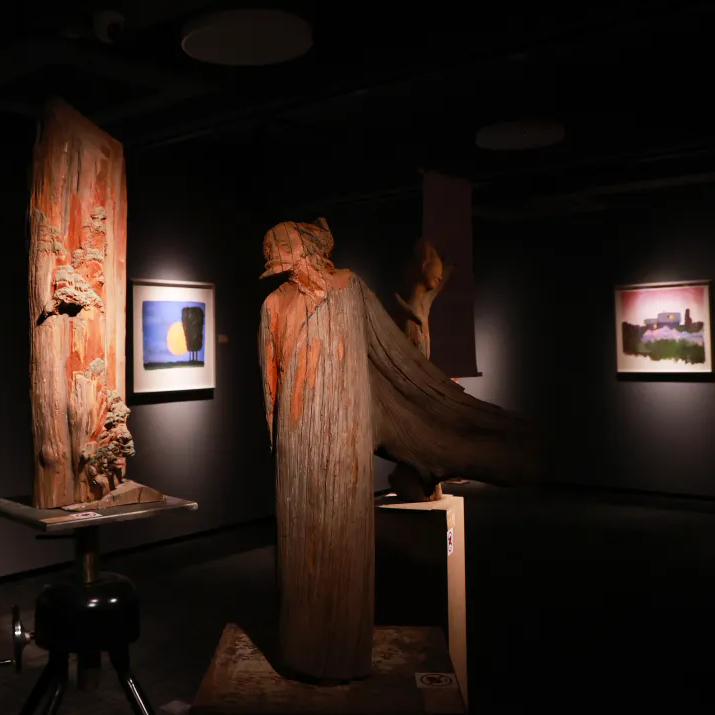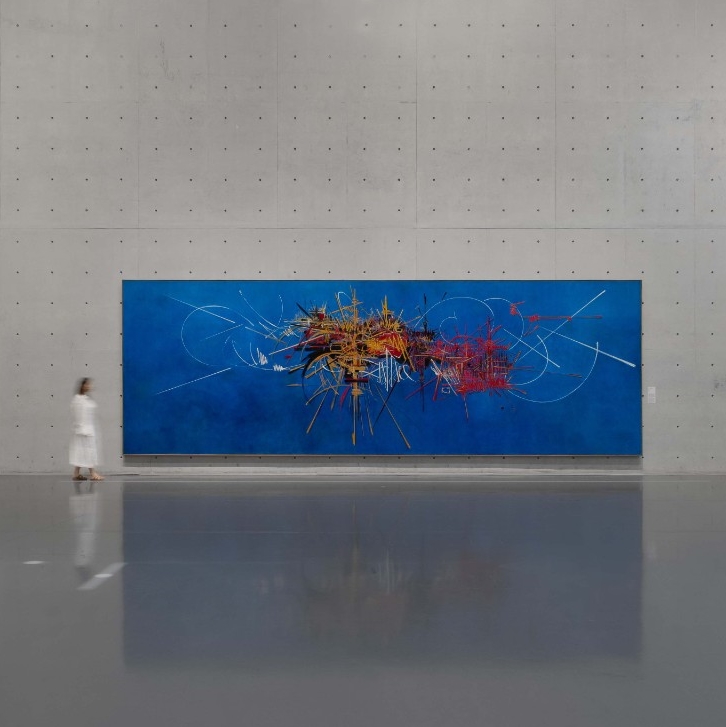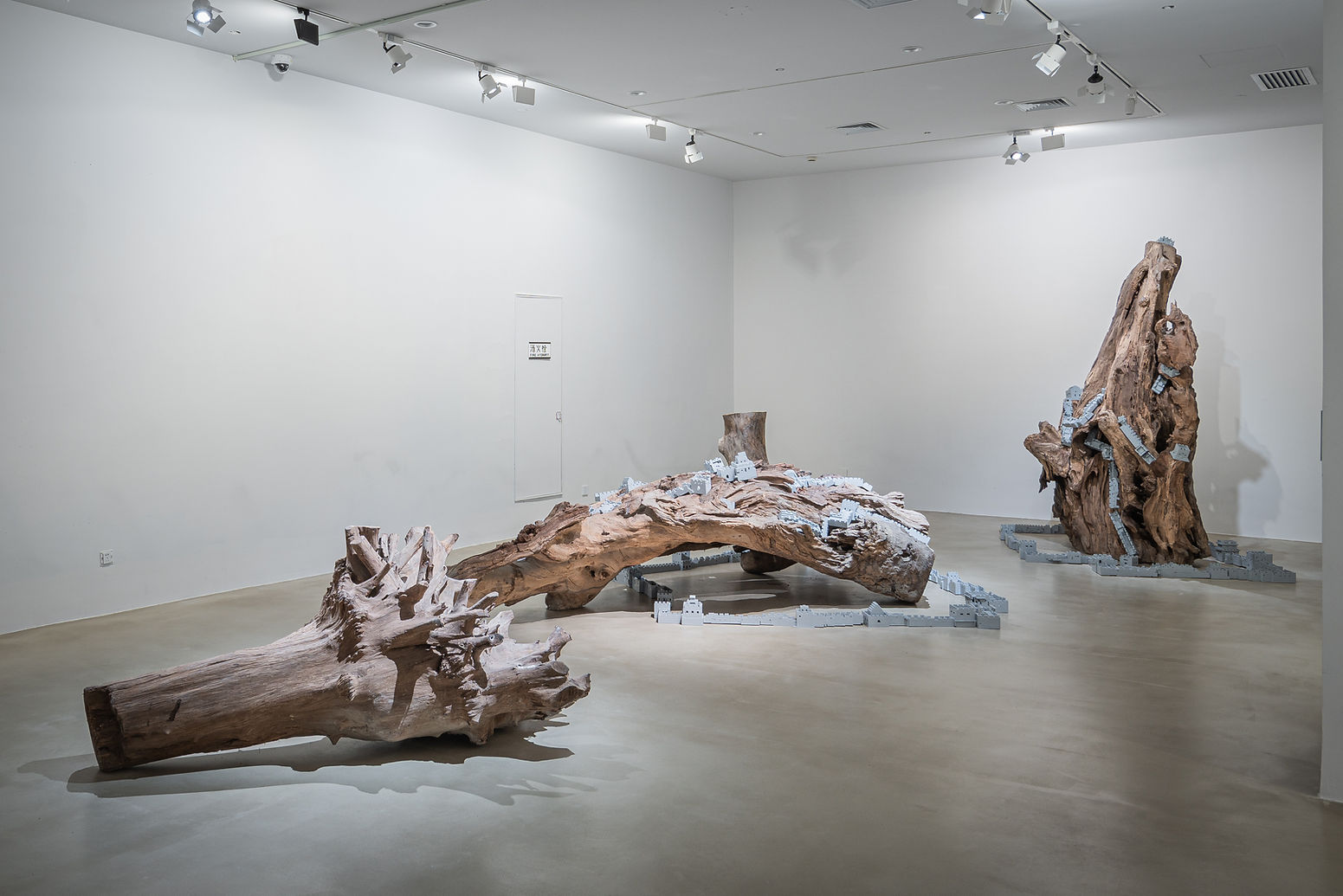
Shen Yuan, Extended Root, 2005-2023. Tree root, gris Lego, 960 x 500 x 260cm
Being one of the first Chinese artists to achieve international reputation, Huang Yongping and Shen Yuan began their career in Chinese avant-garde art in the 1980s, and expanded their work to international horizons in the 1990s, constantly subverting established concepts of history, and creating vibrant ways of expression that transcend national boundaries and cultures. Following their joint exhibition Hong Kong Foot at Tang Contemporary Art, Hong Kong (2017), this exhibition Is Small Still Beautiful? is a selection of works by Shen Yuan from their practice, including six large-scale installations, paintings and video materials. Spanning more than 40 years, from Huang Yong Ping's 1983 oil painting to Shen Yuan's latest large-scale installation Escape the Room (2024), the exhibition presents the two artists' pioneering practice in contemporary art history.
A Question of Size
On Huang Yong Ping and Shen Yuan’s Joint Exhibition “Is Small Still Beautiful?”
Text by Hou Hanru
Today. we suffer from an almost universal idolatry of gigantism. It is therefore necessary to insist on the virtues of smallness - where this applies. - E. F. Schumacher 1
Early in the 1970s, the Germany-British economist Ernst Fredrich Schumacher warned us that excess of production and oversize of economy would become a fatal threat for the future of human being. In his milestone book Small Is Beautiful, written during the oil crisis that had caused an unprecedented economic and social crisis across the world and the collapse of euphoric celebration of consumerism as the ultimate happiness for humankind, he incited us to ask:
What scale is appropriate? It depends on what we are trying to do. The question of scale is extremely crucial today, in political, social and economic affairs just as in almost everything else. 2
This is also true for our cultural and artistic activities. Now, one has become aware that, in the process of the rapid globalization of contemporary art, there has been, for a long time, a kind of cult of large size work, or “idolatry of gigantism”, across the board. Huge objects are being produced to fill up spaces of public and private collections. They are custodied in bigger and bigger, more and more extravagant, museum and gallery spaces. Instead of being cultural, social and political agoras, namely public spaces, they tend to welcome almost uniquely touristic consumptions. Entertainment has replaced public debates on social, political and economic issues and spiritual reflections on the meaning of life. For the last two decades, this has become even more drastically evident in China, the new El Dorado dreamt by all adventurists of global neo-liberal capitalists. Gigantic projects of urbanization, infrastructure construction and commodity production and consumption driven by financial speculations have been carried out. On the other hand, museums, galleries, theaters, parks and other cultural facilities have been created to accommodate bigger and bigger “art works”. Then, it came the interruption of the Covid lock-down. All seem to be put in question. We suddenly find out that we have made too many “art works”, and they are too big...
It's in this context that the exhibition “Is Small Still Beautiful?”, with works by Huang Yongping and Shen Yuan, is to be held at Tang Contemporary Art, Beijing, in late August 2024. The works on show, selected by Shen Yuan, are not necessarily very small. But they are definitely moderate in size and profound in meaning. Moreover, they are absolutely beautiful. The works are gathered together to unveil and denounce a “small secrete” of the big picture of the ambitious modernization and neo-liberal globalization, which have dominated the recent history of the world’s development. In various countries, from France where the artists live to Brazil where they visited, and China they frequently return to, the cult of bigness has been embraced by the authorities, the powerful elites, and, ironically, the normal people, as the sign of the greatest success of human work, the image of dreams-come-true. Bigness has hence become the symbol of “good life”. Many artists also engage themselves with creating large and spectacular works to “celebrate” the “victorious achievement” of human creation. Shen Yuan’s decision to select only seven “modest” works by Huang Yongping, her late husband and collaborator, one of the most original and influential artists of our time, and by herself, equally important as a female creator, aims to expose the fundamental contradiction of such an idolatry of gigantism. Putting in contrast the superficial beauty of the bigness of infrastructural building and the true beauty of the smallness of imaginative actions of the normal people, the carefully selected works are to evoke empathies and supports for the marginalized, populations across the world – in a way, in spite of their successful careers, they have always been sharing the destiny of the marginalized since the artists themselves, driven by the fortune of life, had to leave their original home and settled in a “foreign” land. They have learned, through their devotions to the cause of artistic and cultural avant-gardism, namely, risk-taking, that the real beauty of creation always lays in small but authentic ideas and experiments in the everyday life, such as poor people to create their homes out of all dire conditions. The grass-root populations across the world can always manage to invent ingenious designs as alternatives to expensive mainstream systems in order to improve their life conditions. Living in peripheral zones such as ghettos, favelas and social housing buildings, they struggle to defend cultural diversities deeply rooted in various histories, permanent migration and transformation, that have made up the complex reality of contemporary world, in the face of the homogenization imposed by the dominant powers. Eventually this kind of survival efforts express marvelously the real sense of happiness for human beings. Here, art, with its particular languages and mediums, has become a way to invent and apply, in Schumacher’s words, the “technology with a human face”3. This further leads to opening new perspectives for sustainable developments, and generation of reliable existential conditions for the present and the future of our lives.
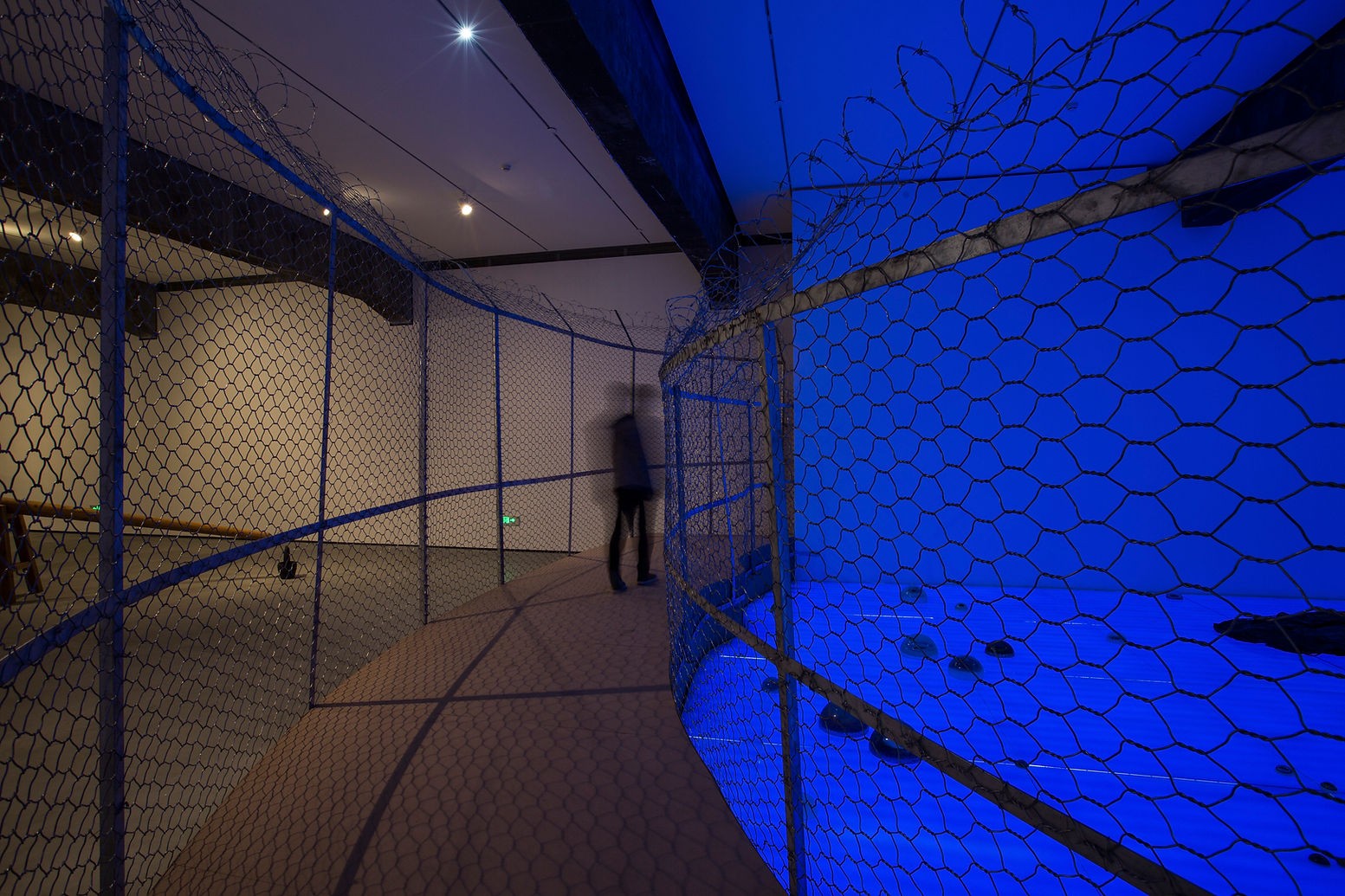
Shen Yuan, I am watched, I have not appeared, 2017. Light box, wire, resin, rubber boat, 980 x 820 x530cm
Paris, as a global cosmopolitan city, is the best test ground for dealing with the question of the relevant size of art creation, in both its forms and contents. It is one of the most important centers of international artistic creation. More significantly, it is a capital for multiculturism par excellence. Having made it their home for the last three decades, Shen Yuan and Huang Yongping have created a major part of their oeuvres in the city, critically exploring and reflecting the intense and complex reality of cultural negotiations and transformations taking place in the city. Shen Yuan’s I am watched, I have not appeared (2016) exposed the terribly dangerous experiences of war refugees entering “illegally” into Europe. The refugees “creatively” improvised all sorts of devises to pass borderlines while the audience are “invited” to watch the ordeal behind barbed wires.
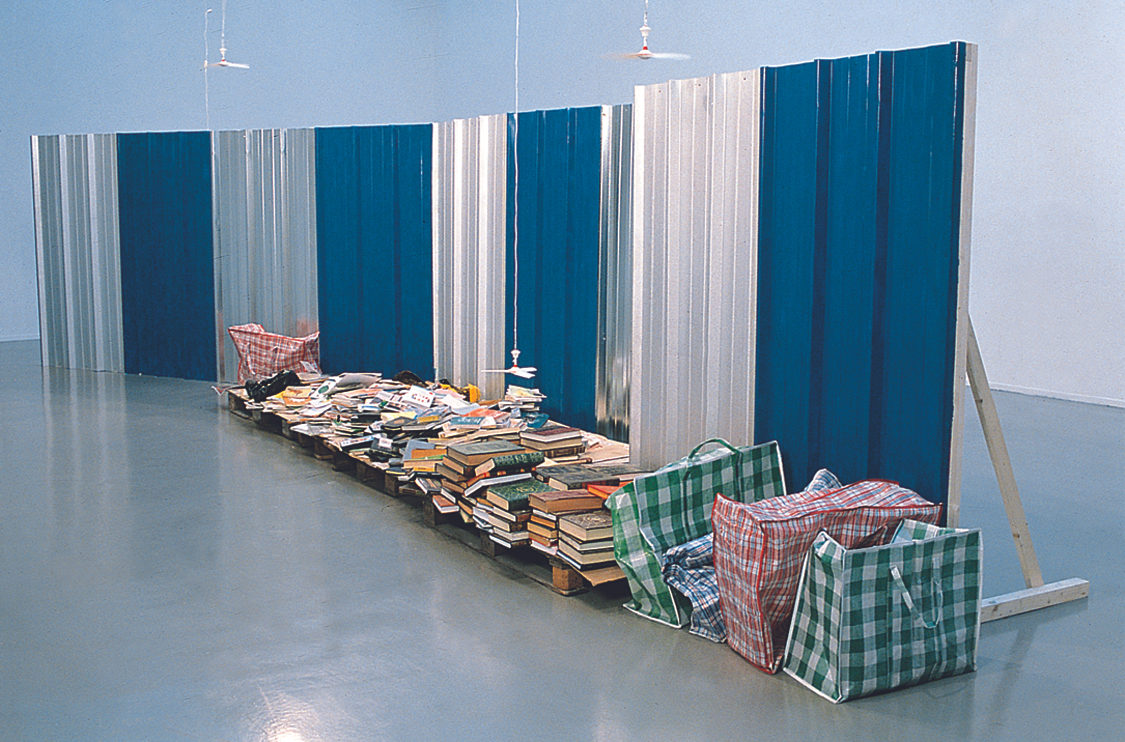
Huang Yongping, Kiosque Flottant, 2000. Sheet metal, bags, the artist's books, arabic books, muyu, small fan (Variable dimensions)
Huang Yongping’s Kiosque Flottant (2000) was inspired by an ad hoc stand selling Arabic books next to a construction site by the Metro station Barbès Rocherchouart near his home in Paris. This kind of impromptu kiosk, with the contents of the books, was often seen as close to the Islamist propaganda threatening mainstream Western cultures. At the same time, it should also be seen as a peculiar way to claim for freedom of expression by marginalized minorities… Huang Yongping reproduced the stand with books purchased from the original stand owner. On the other side of the fence, he added his own collection of Chinese books and religious objects. Together the books and objects convoyed the voices of a certain heresy and evoked the potential revolt of the oppressed. The artist sought to create a “floating scene” on which resistant actions, physically small but persistently elusive, were played out against the dominant powers. The dominant powers were inevitable of gigantic size!
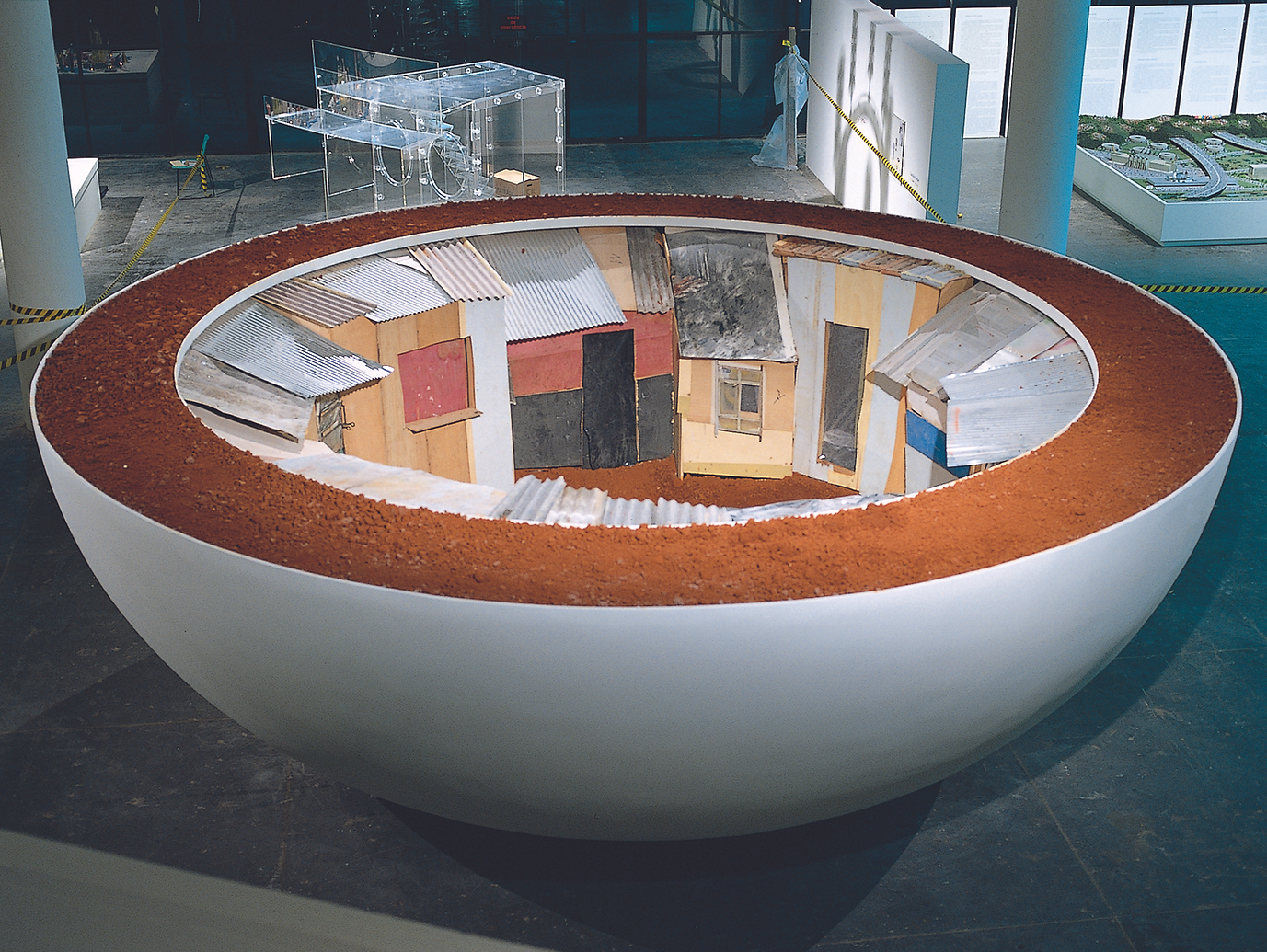
Huang Yongping & Shen Yuan, Flying Bowl, 2002. Wood, iron, fiberglass, soil, 800 x 800 x 275cm
Flying Bowl, an installation created in collaboration by Huang Yongping and Shen Yuan for San Paolo Biennale, Brazil, 2004, is a powerful work that carries with it an even more universally meaningful message. The outside of the work, a large bowl with smooth and pure white surface, was modeled on the Utopian architectural forms of the parliament of Brasilia designed by Oscar Niemeyer, to represent the new democracy of Brazil, a rising leader of the Global South. Inside, there were numerous wooden huts to form a favela, modeled upon the real favela within the same city. The contrast of the tidy and aerodynamic modernist construction and the chaotic and poor favelas uncovered the contradictory nature of the modernist utopia, the one marked by the “Third World Developmentalism”. The reality is like this: hardly had the utopian city been built when it turned dystopian. Clearly, it mounted a critique of the dominant develop mentalistic ideology and policy, which were gigantism-loving. However, it also expressed a certain hope with bottom-up ingenuities to create alternative structures for the marginalized to survive and subvert the established order from within, to open new perspective for more relevant and humane developments. This may be hidden. But it would lead to more smooth organizations of innovative and effective inhabiting structures – homes, and active social spaces, without the lavish and fancy outlooks of new CBDs (central business districts) …
Huang Yongping’s L’Arc de Saint-Gilles (2015) resorts to a well-known Christian legend to “discuss the relationship between man and God, between hunting and protection”4. Dividing the body of the deer into two parts with an arch inserted in the middle, the image of the work, with the subtly balanced tension between the two extremities, incites us to reflect on how to return to a certain equilibrium and harmony between man and nature, between human actions and ethics. The legend of the hermit Saint-Gilles, wounded and then compensated by the King Wamba due to his action to protect the dear hunted by the King, showed a dilemma of human existence in the world: can we conquer nature by violence while wanting to have our sin redeemed? Can an “advanced technology” aimed at exploiting nature, or “non-human livings”, be transformed into a “technology with a human face”?
In other words, the question is, how can we create innovative and “humane” means to surpass the man-made walls of self-separation from the other beings? This is what manifested in Shen Yuan’s Extended Roots (2023), which features a “Great Wall” that separates rich countries from the poor ones…
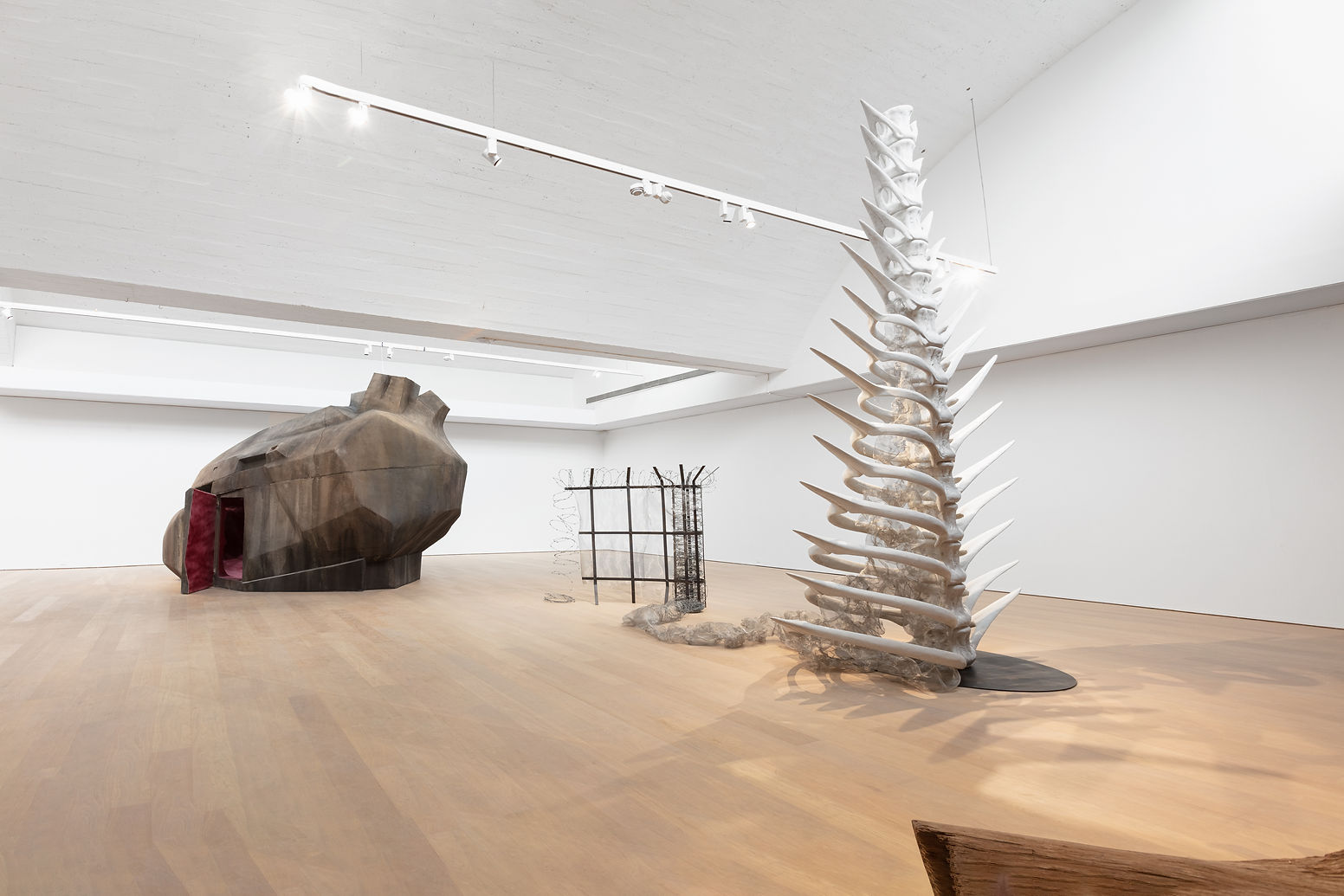
Shen Yuan, Escape the Room, 2024. Fiberglass, wire, 1200 x 700 x 600cm
Yes, we are still struggling to escape from the man-made wall that divide the world into two, or from the bunker that at once protects us from aggressions of the others and isolate us from the outside world, which is much more interesting than ours in general. How to open our minds to embrace others while avoiding being attacked by “strangers”? This remains an eternally unsolvable dilemma, and an endlessly attractive but defying topic for creative minds. In which mode of production and on which scale that we can find any constructive answer to this vital question? Escape from confinements and running away for freedom have been a long-term obsessive theme for Shen Yuan, the artist who is also a doubly displaced “immigrant woman”. How can she escape? Where can she go? For her new project “Escape the Room”, referring to the popular online video game, she designed a bunker in the shape of a human heart. It is also used as a confession room in a church. Facing the omnipresent crisis today, intuitively, we tend to enter this dark confinement for a moment of security. But this “safe room” is too dark and too deadly. Hardly have we entered it when we want to run away from it at all prices. Can we manage to escape from it? This turns out to become an ontological dilemma of our time. The only way to deal with such a dilemma is not to escape at all but simply face the dark reality with courage and intelligence. Then we will blow up the bunker, or our own heart. To do this, we must resort to “technology with a human face”. This is to achieve a state of permanent and dynamic peace between the self and the other, between man and the world. This will ultimately bring us towards the possibility to attain a state of true happiness – to live without fear. And this can be a revelation of the real meaning of being artist and “producing” art.
All these echo beautifully the beautiful concept of “Buddhist Economy”, defended with great enthusiasm by E.F. Schumacher“Buddhist Economy”5, according to a now commonly recognized principle, puts forward “GNH (Gross National Happiness)” instead of “GDP (Gross Domestic Product)” as a key indicator and a goal of economic, cultural, spiritual and social developments. Here, it is valuable to notify that the concept of GNH6 was created in 1972 by Jigme Sinye Wangchuck, the King of Bhutan, one of the smallest countries in the world, a peaceful neighbor of both China (Tibet) and India, the countries with the biggest populations and with the most ambitious projects of development and modernization, dominated by the logic of developmentalism and drive for geopolitical grandeurs. But we still need to ask, on which side of the border we can encounter real happiness? Is smaller more beautiful than the bigger?
Written in Briançon, a small French city on the highest altitude of Alps, with bright sunshine and solid fortresses…
25/07/2024
Notes
1 F. Schumacher’s “Small Is Beautiful” (Five, a question of size) , Harper Perenial, 1989, p. 70
2 Ibid, p. 71
3 F. Schumacher’s “Small Is Beautiful” (Ten, Technology with a Human Face), Harper Perenial, 1989, pp.115-172
4 Huang Yong Ping, notes on “L’Arc de Saint-Gilles”, 2015
5 E. F. Schumacher’s “Small Is Beautiful” (Four, Buddhist Economy), Harper Perenial, 1989, pp. 56-67
6 https://en.wikipedia.org/wiki/Gross_National_Happiness
About the Exhibition
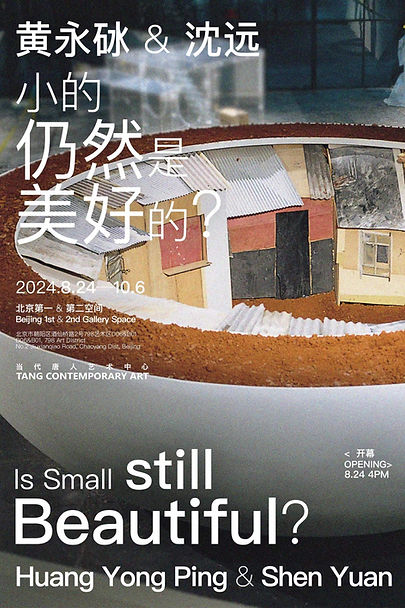
Dates: Aug.24 - Oct.6, 2024
Venue: Beijing 1st & 2nd Space
Courtesy of Tang Contemporary Art.


